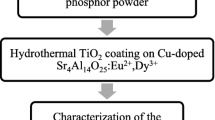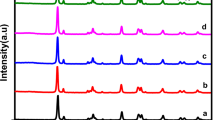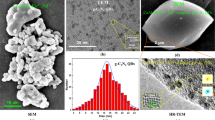Abstract
In the recent years, exploring new materials with the photocatalytic functions is a hot research subject, but most of the photocatalysts need an excitation source during the photocatalytic process. In this work, we report the double-perovskite La2MgTiO6:Eu2+ phosphor having the purple-blue afterglow luminescence. Our PL results show that the samples upon excitation at the UV light can show a broad Eu2+ band with the maximum emission intensity at 387 nm. The afterglow range is found to match with the UV absorption region of the TiO2. As a result, we design the UV converted Eu2+ afterglow composite by serving the La2MgTiO6:Eu2+ phosphor as a ceramic substrate to immobilize the TiO2. The photocatalytic experiments reveal the afterglow behavior of La2MgTiO6:Eu2+ phosphor can continuously provide the UV photons to the TiO2 absorption, leading to a continuous-photocatalytic methyl orange degradation in the absence of UV irradiation. Together with the photocatalytic process under the UV irradiation and after removal off the excitation source, a maximum photocatalytic time of 3.5 h is detected.






Similar content being viewed by others
References
J. Schneider, M. Matsuoka, M. Takeuchi, J. Zhang, Y. Horiuchi, M. Anpo, D.W. Bahnemann, Understanding TiO2 photocatalysis: mechanisms and materials. Chem. Rev. 114, 9919–9986 (2014). https://doi.org/10.1021/cr5001892
J.-M. Herrmann, C. Duchamp, M. Karkmaz, B.T. Hoai, H. Lachheb, E. Puzenat, C. Guillard, Environmental green chemistry as defined by photocatalysis. J. Hazard. Mater. 14, 624–629 (2007). https://doi.org/10.1016/j.jhazmat.2007.04.095
A.R. Khataee, M.B. Kasiri, Photocatalytic degradation of organic dyes in the presence of nanostructured titanium dioxide: influence of the chemical structure of dyes. J. Mol. Catal. A Chem. 328, 8–26 (2010). https://doi.org/10.1016/j.molcata.2010.05.023
W.L. da Silva, M.Z. Lansarin, P.R. Livotto, J.H.Z. dos Santos, Photocatalytic degradation of drugs by supported titania-based catalysts produced from petrochemical plant residue. Powder Technol. 279, 166–172 (2015). https://doi.org/10.1016/j.powtec.2015.03.045
V. Nogueira, I. Lopes, T. Rocha-Santos, F. Gonçalves, R. Pereira, Treatment of real industrial wastewaters through nano-TiO2 and nano-Fe2O3 photocatalysis: case study of mining and kraft pulp mill effluents. Environ. Technol. 39, 1586–1596 (2018). https://doi.org/10.1080/09593330.2017.1334093
Y.Y. Yang, L. Kang, H. Li, Enhancement of photocatalytic hydrogen production of BiFeO3 by Gd3+ doping. Ceram. Int. 45, 8017–8022 (2019). https://doi.org/10.1016/j.ceramint.2018.12.150
H. Li, L. Luo, P. Kunal, C.S. Bonifacio, Z.Y. Duan, J.C. Yang, S.M. Humphrey, R.M. Crooks, G. Henkelman, Oxygen reduction reaction on classically immiscible bimetallics: a case study of RhAu. J. Phys. Chem. C 122, 2712–2716 (2018). https://doi.org/10.1021/acs.jpcc.7b10974
W. Chen, L. Chang, S.-B. Ren, Z.-C. He, G.-B. Huang, X.-H. Liu, Direct Z-scheme 1D/2D WO2.72/ZnIn2S4 hybrid photocatalysts with highly-efficient visible-light-driven photodegradation towards tetracycline hydrochloride removal. J. Hazard. Mater. 384, 121308 (2020). https://doi.org/10.1016/j.jhazmat.2019.121308
L. Kang, H.L. Du, X. Du, H.T. Wang, W.L. Ma, M.L. Wang, F.B. Zhang, Study on dye wastewater treatment of tunable conductivity solid-waste-based composite cementitious material catalyst. Desalin. Water Treat. 125, 296–301 (2018). https://doi.org/10.5004/dwt.2018.22910
T.C. Long, N. Saleh, R.D. Tilton, G.V. Lowry, B. Veronesi, Titanium dioxide (P25) produces reactive oxygen species in immortalized brain microglia (BV2): implications for nanoparticle neurotoxicity. Environ. Sci. Technol. 40, 4346–4352 (2006). https://doi.org/10.1021/es060589n
P.A. Pekakis, N.P. Xekoukoulotakis, D. Mantzavinos, Treatment of textile dyehouse wastewater by TiO2 photocatalysis. Water Res. 40, 1276–1286 (2006)
P. Pichat, J. Disdier, C. Hoang-Van, D. Mas, G. Goutailler, C. Gaysse, Purification/deodorization of indoor air and gaseous effluents by TiO2 photocatalysis. Catal. Today 63, 363–369 (2000)
J. Zhu, J. Luo, Effects of entanglements and finite extensibility of polymer chains on the mechanical behavior of hydrogels. Acta Mech. 229, 1703–1719 (2018). https://doi.org/10.1007/s00707-017-2060-8
S. Jiang, M.J. Lian, C.W. Lu, S.L. Ruan, Z. Wang, B.Y. Chen, SVM-DS fusion based soft fault detection and diagnosis in solar water heaters. Energy Explor. Exploitat. 37, 1125–1146 (2019). https://doi.org/10.1177/0144598718816604
X.B. Chen, L. Liu, P.Y. Yu, S.S. Mao, Increasing solar absorption for photocatalysis with black hydrogenated titanium dioxide nanocrystals. Science 331, 746–750 (2011). https://doi.org/10.1126/science.1200448
L. Suljo, C. Phillip, B.I. David, Plasmonic-metal nanostructures for efficient conversion of solar to chemical energy. Nat. Mater. 10, 911–921 (2011). https://doi.org/10.1038/nmat3151
L. Kang, L. Zhao, S. Yao, C.X. Duan, A new architecture of super-hydrophilic β-SiAlON/graphene oxide ceramic membrane for enhanced anti-fouling and separation of water/oil emulsion. Ceram. Int. 45, 16717–16721 (2019). https://doi.org/10.1016/j.ceramint.2019.05.195
M. Nolan, Surface modification of TiO2 with metal oxide nanoclusters: a route to composite photocatalytic materials. Chem. Commun. 47, 8617–8619 (2011). https://doi.org/10.1039/C1CC13243A
M. Anpo, H. Nakaya, S. Kodama, Y. Kubokawa, K. Domen, T. Onishi, Photocatalysis over binary metal oxides. Enhancement of the photocatalytic activity of titanium dioxide in titanium-silicon oxides. J. Phys. Chem. 90, 1633–1636 (1986). https://doi.org/10.1021/j100399a036
L.G. Devi, R. Kavitha, A review on non metal ion doped titania for the photocatalytic degradation of organic pollutants under UV/solar light: role of photogenerated charge carrier dynamics in enhancing the activity. Appl. Catal. B Environ. 140–141, 559–587 (2013). https://doi.org/10.1016/j.apcatb.2013.04.035
H.C. Sun, H.Y. Wu, Y.H. Jin, Y. Lv, G.F. Ju, L. Chen, Z.Y. Feng, Y.H. Hu, Photocatalytic titanium dioxide immobilized on an ultraviolet emitting ceramic substrate for water purification. Mater. Lett. 240, 100–102 (2019). https://doi.org/10.1016/j.matlet.2018.12.135
L. Zhao, L. Kang, S. Yao, Research and application of acoustic emission signal processing technology. IEEE Access 7, 984–993 (2019). https://doi.org/10.1109/ACCESS.2018.2886095
J. Su, Z.-G. Sheng, L.-B. Xie, G. Li, A.X. Liu, Fast splitting based tag identification algorithm for anti-collision in UHF RFID system. IEEE Trans. Commun. 67, 2527–2538 (2019). https://doi.org/10.1109/TCOMM.2018.2884001
J. Su, Z.-G. Sheng, V.C.M. Leung, Y.-R. Chen, Energy efficient tag identification algorithms for RFID: survey, motivation and new design. IEEE Wirel. Commun. 26, 118–124 (2019). https://doi.org/10.1109/MWC.2019.1800249
S.K. Guo, R. Chen, H. Li, T.L. Zhang, Y.Q. Liu, Identify severity bug report with distribution imbalance by CR-SMOTE and ELM. Int. J. Softw. Eng. Knowl. Eng. 29, 139–175 (2019). https://doi.org/10.1142/S0218194019500074
S.K. Guo, R. Chen, M.M. Wei, H. Li, Y.Q. Liu, ensemble data reduction techniques and multi-RSMOTE via fuzzy integral for bug report classification. IEEE Access 6, 45934–45950 (2018). https://doi.org/10.1109/ACCESS.2018.2865780
H. Li, G.F. Gao, R. Chen, X. Ge, S.K. Guo, L.-Y. Hao, The influence ranking for testers in bug tracking systems. Int. J. Softw. Eng. Knowl. Eng. 29, 93–113 (2019). https://doi.org/10.1142/S0218194019500050
D. Yuan, M. Sun, S. Tang, Y. Zhang, Z. Wang, J. Qi, Y. Rao, Q. Zhang, All-solid-state BiVO4/ZnIn2S4 Z-scheme composite with efficient charge separations for improved visible light photocatalytic organics degradation. Chin. Chem. Lett. (2019). https://doi.org/10.1016/j.cclet.2019.09.051
J. Zhao, Y. Jing, J. Zhang, Y. Sun, Y. Wang, H. Wang, X. Bi, Aged refuse enhances anaerobic fermentation of food waste to produce short-chain fatty acids. Bioresour. Technol. 289, 121547 (2019). https://doi.org/10.1016/j.biortech.2019.121547
J.B. Lian, Y. Liang, F.L. Kwong, Z.M. Ding, D.H.L. Ng, Template-free solvothermal synthesis of ZnO nanoparticles with controllable size and their size-dependent optical properties. Mater. Lett. 66, 318–320 (2012). https://doi.org/10.1016/j.matlet.2011.09.007
W. Wang, Z.F. Mu, S.A. Zhang, Q.P. Du, Y. Qian, D.Y. Zhu, F.G. Wu, Bi3+ and Sm3+ co-doped La2MgGeO6: a novel color-temperature indicator based on different heat quenching behavior from different luminescent centers. J. Lumin. 206, 462–468 (2019). https://doi.org/10.1016/j.jlumin.2018.10.112
J. Zhao, M. Xin, J. Zhang, Y. Sun, S. Luo, H. Wang, Y. Wang, X. Bi, Diclofenac inhibited the biological phosphorus removal: Performance and mechanism. Chemosphere. 243, 125380 (2019). https://doi.org/10.1016/j.chemosphere.2019.125380
H.L. Du, C.Y. Ma, W.X. Ma, H.T. Wang, Microstructure evolution and dielectric properties of Ce-doped SrBi4Ti4O15 ceramics synthesized via glycine-nitrate process. Process. Appl. Ceram. 12, 303–312 (2018). https://doi.org/10.2298/pac1804303d
H. Chen, Sh Zhang, Z. Zhao, M. Liu, Q. Zhang, Application of dopamine functional materials in water pollution control. Process in Chemistry 31, 571–579 (2019). https://doi.org/10.7536/PC180823
Z.F. Mu, Y.H. Hu, Y.H. Wang, H.Y. Wu, C.J. Fu, F.W. Kang, The structure and luminescence properties of long afterglow phosphor Y3– xMnxAl5– xSixO12. J. Lumin. 131, 676–681 (2011). https://doi.org/10.1016/j.jlumin.2010.11.016
Z.F. Mu, Y.H. Hu, H.Y. Wu, C.J. Fu, F.W. Kang, The structure and luminescence properties of a novel orange emitting phosphor Y3MnxAl5-2 xSixO12. Phys. B 406, 864–868 (2011). https://doi.org/10.1016/j.physb.2010.12.015
P.S. Fortunate, S.N.-T. Misael, Removal of methyl orange (MO) from water by adsorption onto modified local clay (Kaolinite). Phys. Chem. 6, 39–48 (2016). https://doi.org/10.5923/j.pc.20160602.02
H. Chen, A.G. Zhong, J.Y. Wu, J. Zhao, H. Yan, Adsorption behaviors and mechanisms of methyl orange on heat-treated palygorskite clays. Ind. Eng. Chem. Res. 51, 14026–14036 (2012). https://doi.org/10.1021/ie300702j
M. Inagaki, M. Nonaka, F. Kojin, T. Tsumura, M. Toyoda, Cyclic performance of carbon-coated TiO2 for photocatalytic activity of methylene blue decomposition. Environ. Technol. 27, 521–528 (2010). https://doi.org/10.1080/09593332808618669
L.W. Zhang, H.B. Fu, Y.F. Zhu, Efficient TiO2 photocatalysts from surface hybridization of TiO2 particles with graphite-like carbon. Adv. Funct. Mater. 18, 2180–2189 (2008). https://doi.org/10.1002/adfm.200701478
Acknowledgements
This work was financially supported by the Innovative University Projects of Guangdong province (Project No. 831783), and the Quality Engineering Construction Projects of Beijing Institute of Technology University (Zhuhai Campus) (Project No. 2016003ZL, and 2017007JXGG), as well as Longshan academic talent research supporting program of Southwest University of Science and Technology (Project No. 18lzxt03, and No. 18zx309) and Southwest University of Science and Technology Natural Science Foundation (Project No. 18zx7125).
Author information
Authors and Affiliations
Corresponding authors
Additional information
Publisher's Note
Springer Nature remains neutral with regard to jurisdictional claims in published maps and institutional affiliations.
Rights and permissions
About this article
Cite this article
Huang, J., Qin, M., Yu, J. et al. La2MgTiO6:Eu2+/TiO2-based composite for methyl orange (MO) decomposition. Appl. Phys. A 125, 862 (2019). https://doi.org/10.1007/s00339-019-3147-y
Received:
Accepted:
Published:
DOI: https://doi.org/10.1007/s00339-019-3147-y




